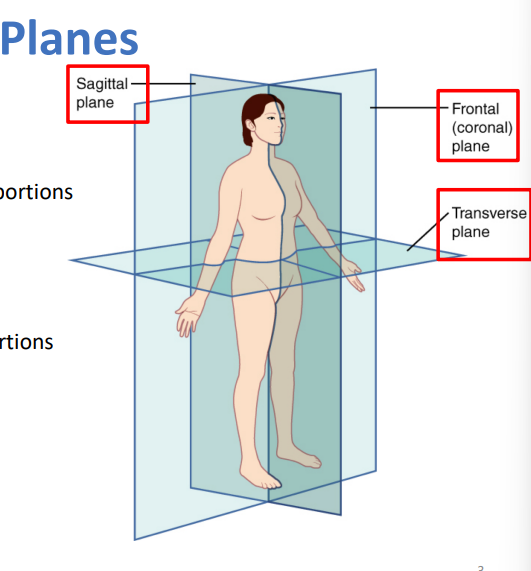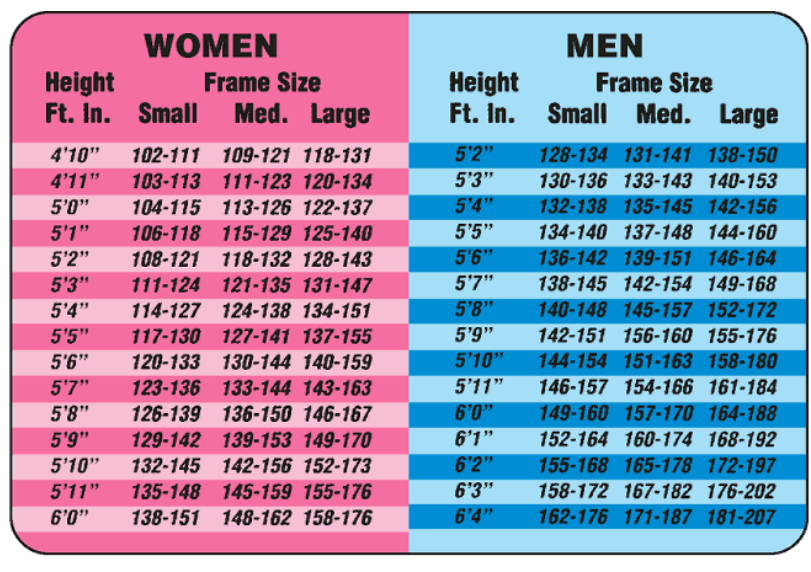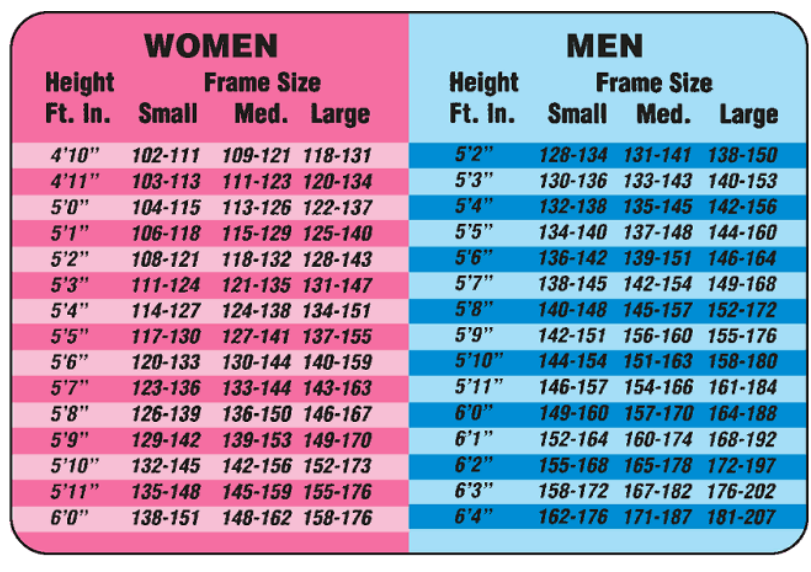BPK 142 - Osteology and Arthrology Part Two
1/41
There's no tags or description
Looks like no tags are added yet.
Name | Mastery | Learn | Test | Matching | Spaced |
|---|
No study sessions yet.
42 Terms
Name all 3 reference planes of the body
frontal plane
anterior and posterior portions
sagittal plane
right and left sides
transverse plane
superior and inferior portions

name the joint conditions
sprain - overstretching of ligaments
dislocation - bones are displaced
subluxation - partial dislocation
bursitis - inflames bursae
arthritis - joint inflammation
what is a sprain? what are the degrees?
overstretching of ligaments
1st degree - fibers are stretched
2nd degree - partial tear of ligament
3rd degree - rupture of ligament
what is a dislocation? what may happen? what joints are most vulnerable?
displacement of bones
ligaments may be sprained (even torn) in severe cases
blood vessels are often ruptures
nerves may be compressed
shoulder and knee joints are most vulnerable
what is subluxation and what is its etiology?
partial dislocation
trauma, infection
what is bursitis and what is its etiology?
inflamed bursae
trauma, infection
what is arthritis and what is its etiology?
joint inflammation
trauma, infection, metabolic disorders, age
what are the structural limits to flexibility?
bony structure of joints (the way your bones sit on top of each other —> less bones = more flexible)
ligaments - limits range of motion
joint capsules - meant to provide stabilization (not a lot of movement)
muscle-tendon unit - muscle and its fascial sheaths
the major focus of stretching exercises is the elongation of this tissue
name the elements that comprise the human body
oxygen 65%
carbon 18.5%
hydrogen
nitrogen
calcium
phosphorus
potassium
sulfur
sodium
chlorine
magnesium
what are the main tissue types that the body is composed of?
nervous
epithelial (skin)
muscle
connective (very general term - ex. blood is one)
what are the three major structural components the body is made up on?
muscle
skeleton (bone)
fat
what factors do the distribution of the structural components of the human body depend on?
sex
genetic characteristics
age
lifestyle
what is the two-component model of body composition?
the amount of fat and fat-free mass of which the body is composed

what are fat-free masses of the body primarily composed of?
bone
muscle
water
vital organs
connective tissue
body mass = ?
fat mass + lean body mass
what is chemical composition of body (four component model)?
fat
fat free
protein
mineral
water
what is anthropometry? why do we do it? what does it compose of?
quantitative measurement of body size and proportions
to understand human physical variation and body comp
skinfold thicknesses
circumferences
bony widths and lengths
height
body weight
why assess body composition?
to monitor changes in body composition associated with growth, maturation, and aging
to distinguish normal from disease states
to establish optimal ranges for health and performance of athletes in sports
track goals for weight management or strength training
important for health to know
association between obesity and chronic disease risk
very low levels of fat are also a risk
what are some complications associated with excessive thinness
bone fractures
muscle wasting
reproductive disorders
what are some complications associated with obesity?
stroke
sleep apnea
reduced fertility
heart failure
what are eating disorders?
a disturbance in eating behaviors that jeopardizes a person’s physical/psychological health
name some eating disorders
anorexia nervosa
bulimia nervosa
binge eating disorder
female athlete triad
composed of 3 things: - disordered eating, excessive exercise, emotional stress
what’s essential fat?
fat that is required for normal physiological functionning
structural components of the cell membranes
synthesis of certain hormones
transport of fat-soluble vitamins
what’s storage fat?
fat that is stored in adipose tissue for energy supply purposes
located underneath the skin (subcutaneous), in the abdominal cavity, and around certain organs (visceral fat)
useable if not enough energy is available from other sources
what are the differences of fat between males and females?
the average male is taller, heavier, larger muscle mass = less total body fat content
ages 20-24
storage fat:
female = 15%
male = 12&
essential fat:
female = 12%
male = 3%
females have sex specific fat deposits in the breasts, pelvic and thigh regions
what are the fat deposition patterns?
location of excess storage fat is sex specific
male - android (apple
upper torso
abdomen
female - gynoid (pear)
thighs
hips
buttocks
after menopause, females begin depositing more fat into abdominal area
characteristics of obesity
BMI ≥ 30 (previously standard)
body fat % ≥ 20% (males) or 30% (females)
combination of type 2 diabetes and obesity is one of the largest epidemics the world has faced
increasing around the world
characteristics of adult obesity
number of canadians overweight/obese has been steadily increasing last 25 years
over 60% of canadians are overweight/obese
overweight percentages increase every year
characteristics of childhood obesity in canada
children are taller, heavier, bigger, and weaker than in 1981
obese children at ages 6-9 have a 55% chance of becoming obese as adults
10x the risk of normal children
an obese child costs the health care system about 3x than a child of healthy weight
what are the causes of the obesity epidemic?
caloric intake exceeds caloric expenditure
decreased physical activity
less need to walk to do daily errands, video games, etc.
increased consumption of calories
processed foods
high sugar intake (pop)
“everythings bigger in texas” - larger portion sizes
social environment
pressure to consume, influencers (mukbangs)
biology - epigenetics:
changes in a chromosome that affect gene activity and expression
any heritable phenotypic change that doesn’t involve genetic modification
genetic makeup doesn’t cause obesity but lowers the threshold for its development
ex. insulin production decreases: poor regulation of blood sugar: diabetes: insulin rejection: weight gain
what are changes associated with aging in a prosperous, industrial society? how can they be slowed down?
increased fat mass
decreased muscle mass - sarcopenia
decreased bone mass
can be slowed with regular exercise and proper dietary habits
what leads to skeletal fragility in elderly women?
failure to obtain an optimal level of bone mass during childhood
requires proper nutrition, healthy body composition, and regular exercise
what are common direct and indirect techniques for assessing body composition?
direct
chemical analysis of human cadaver
indirect
noninvasive techniques used on living persons
what are the indirect methods for assessing body composition?
height - weight tables
body density & volume measurements
weight - height indices
waist circumference
skinfold measurements
CSEP - PATH Body Composition Assessment
O-scale system
bioelectric impendence analysis
what are height - weight tables? what are their criticisms?
desirable weight with regard to the lowest death rates predicted from tables
developed by insurance actuaries
criticisms:
dont take body comp into consideration
data collected from white middle aged population
no way to assess frame size accurately

what are body density and volume measurements?
density = mass/volume
body density varies with the amount of body fat
greater proportion of fat -→ lower body density
methods of mesurement:
volumetry: measure the amount of air displaced
underwater weighting (hydrostation weighting)
measure water displaced
not a good method because doesnt consider body comp (depends on age, race, sex, etc)
densitometry should not be used as a universal criterion for prediction of fat %
4 component model equations > 2 component model equations

weight - height indices? what does it not consider? criticms?
bmi - weight/height² (units: kg/m²)
used as an indicator of obesity
bmi:
less 18.5 = underweight
25-29.9 = overweight
30+ = obese
does not consider
body comp
fat distribution
amount of visceral fat
cut off points need revision because ethnicities differ relationships
south asian and chinese ppl have more visceral fat than white ppl
criticms: does not diffrienciate body comp
athletes tend to have bmis in the overweight range
what is waist circumference in terms of assessing body comp? with what other method is it used with to be more effective?
inexpensive and effective way to assess central obesity
may be better than bmi
used in conjunction with bmi to be more reliable (CSEP-PATH)
how to use skinfold measurements? what is rationale? assumptions about it? what are the 2 types of body comp prediction equations? what is measurment error %?
how? 2 ways:
use sum of # of skinfolds as a indication of relative fatness among individuals
use fat folds in conjunction with equations/tables to predict % body fat
assumptions when using:
constant densities in 2 compartment level
proper identification of site and proper technique
constant compressibility of skinfold
fixed adipose tissue pattern (can differ per hormones)
fixed proportion of internal to external fat
basically just ideal methods and subjects
2 equations:
population specific
developed from small homogenous samples - only can apply eqtn to that sample
generalized sample
developed from large heterogeneous samples - wider application available
but be careful when using them on extreme cases of populations (obese ppl, atheletes)
measurement error % is 3-4%? no i think cuz o-scale is used to combat it)
why is o-scale system used? what does it require, provide? what scale does it use?
used to combat skinfold measurement error
requires
8 skin folds
10 girths
4 skinfold-corrected girths
2 bone breadths
provides
adiposity rating
proportional weigh rating
uses stamina scale
how is bioelectrical impedance analysis used? how can results fluctuate in a subject? how can prediction equations be validated? what is error % fat estimation? how equations have errors in estimations?
used to measure resistance to the flow of energy in body
impedance is greater in adipose tissue than in bone + muscle
higher the impedance = the fatter the subject (because the subject is less conductive) (bcz theres less water in adipose tissue than muscle)
fluctuations in water content in subjects need to be standardized because they can affect the optimum results
validated using underwater weighting
equations tend to not estimate fat mass well.
need to use equations per populations
error %: approx. 3-5% on top of body density
what is the other procedure used in assessing body comp - new gold standard. what is it widely used to measure?
what are the other 2 common ones? what are their advantages?
dual energy x-ray absorptiometry (DEXA)
widely used to perform bone mineral density measurements
CT, MRI are also gold standards too
advangtages: distinguish between subcutaneous vs visceral adipose tissue